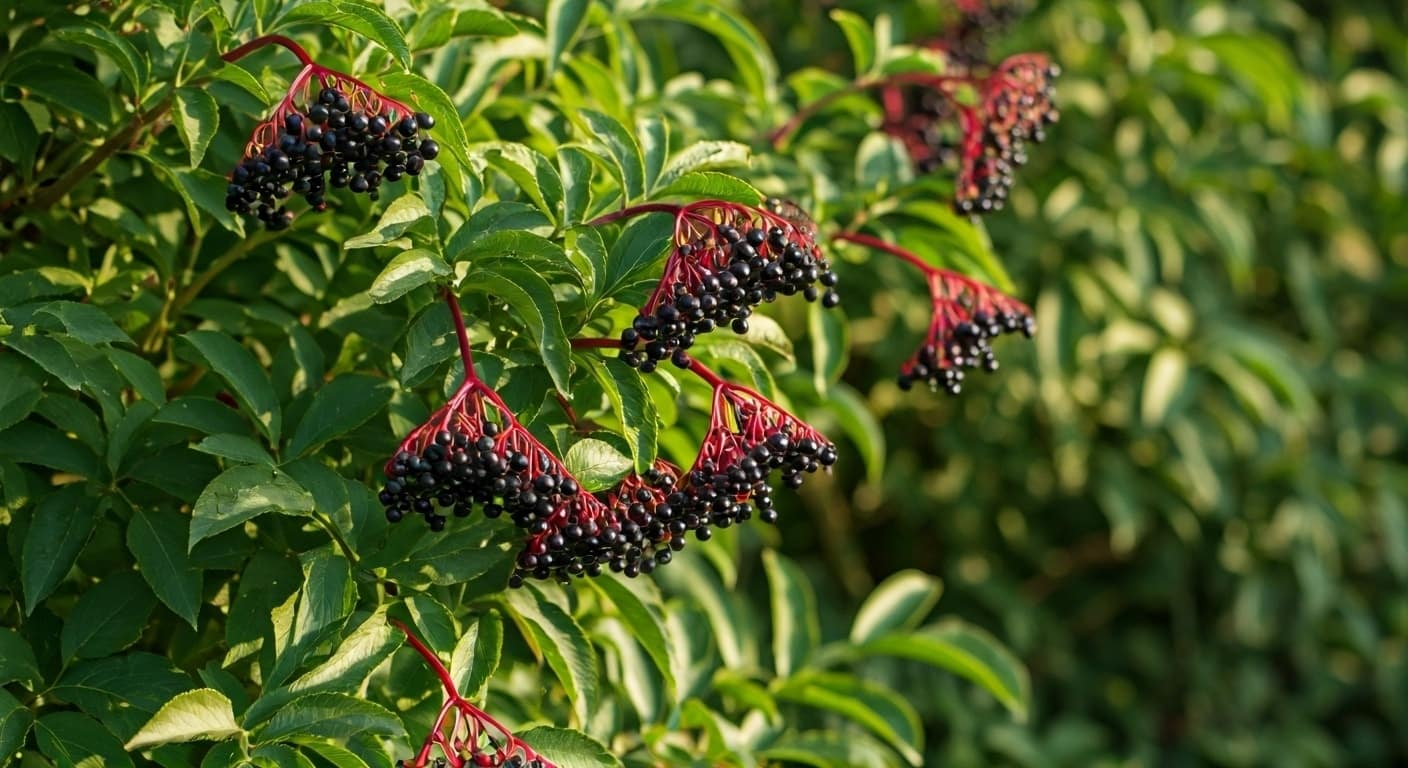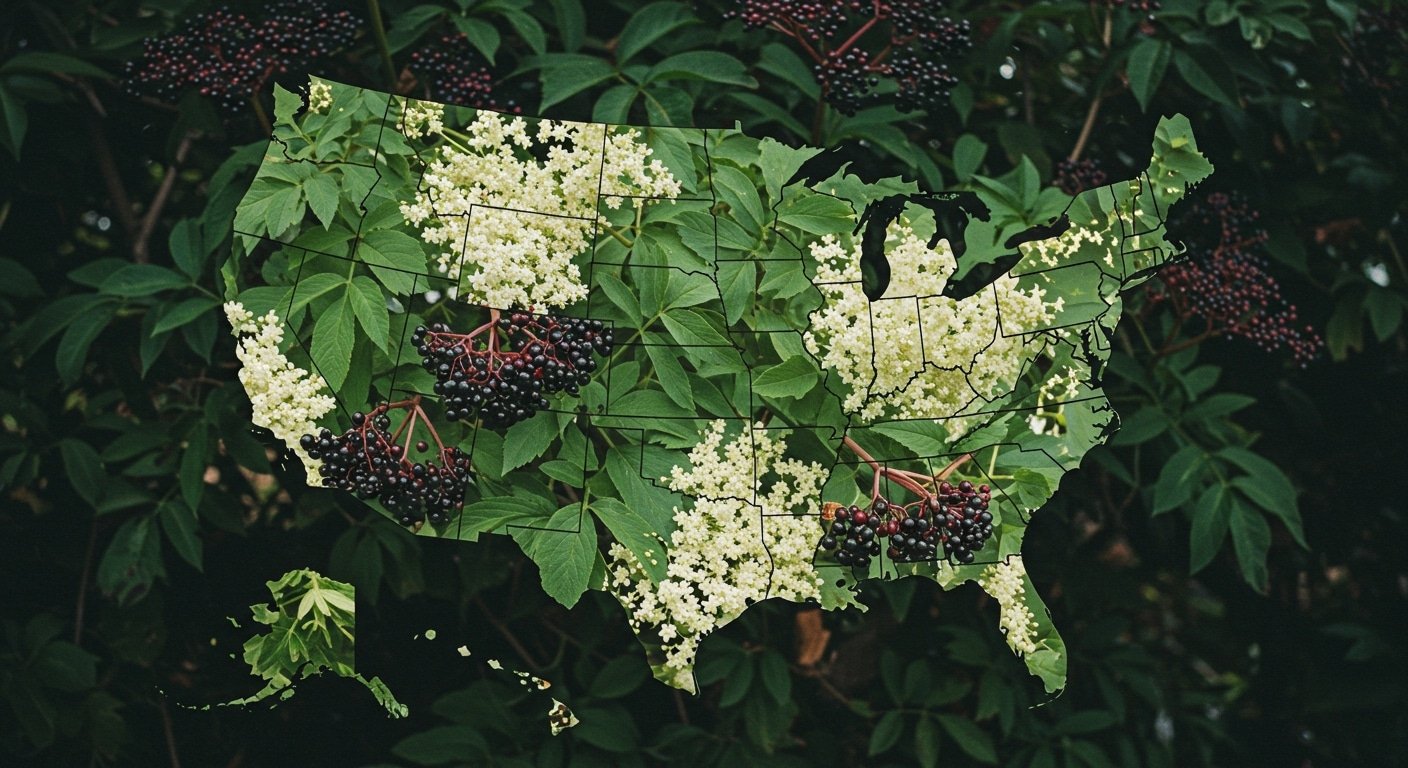
Why Elderberry Plants Are Worth Growing
Elderberry bushes provide fruit rich in antioxidants and vitamin C, and they’re versatile in the kitchen for syrup, jelly, wine, and pies. The shrubs bloom with white flower clusters in late spring and set dark purple berries in late summer, offering both beauty and utility.
Nutritional and Medicinal Benefits
Elderberry fruit is widely used for cooked preparations such as syrup, jam, jelly, and wine. Many gardeners plant elderberries to keep a steady supply of fruit for preserves and culinary uses.
Wildlife and Landscaping Value
Elderberry shrubs support birds and pollinators, provide seasonal interest, and fit well into hedgerows and edible landscapes. Their mature size (often 8–12 feet tall and wide) makes them useful as screens and wildlife-friendly plantings.
American vs European Elderberry — Which Should You Buy?
Choosing between Sambucus canadensis (American elderberry) and Sambucus nigra (European elderberry) depends on climate, use, and availability. Most home growers in North America prefer American elderberry for adaptability and reliable cropping.
Sambucus canadensis (American elderberry)
Well adapted to many North American climates, tolerates full sun to part shade, and handles periodic moisture. Popular fruiting cultivars include York, Adams, Nova, Bob Gordon, and Wyldewood.
Sambucus nigra (European elderberry)
Common in Europe and available from specialty sources. Some ornamental S. nigra selections are grown for foliage and flowers rather than fruit quality; confirm you’re purchasing edible, fruiting types if jam or syrup is your goal.
Best Elderberry Varieties to Buy
The most available fruiting cultivars for home growers are productive, cold-hardy, and pair well for cross-pollination. Planting two different cultivars that bloom together improves fruit set and berry size.
York vs Nova
York is known for very large berries and pairs well with Nova for cross-pollination. Nova ripens in August in many regions and performs in full sun or part shade. Together they offer consistent yields for juice and preserves.
Adams
Adams tolerates heavier soils and periodic wet spots better than many fruiting shrubs. It produces heavy clusters of purple-black berries and is a dependable pollination partner with other American elderberry cultivars.
Bob Gordon
Bob Gordon forms pendulous clusters that can reduce bird damage and often extends harvest into late season. It’s a strong producer with large, high-quality fruit for syrup, jelly, and wine.
Where to Buy Elderberry Plants Near Me
You can buy elderberry plants locally at nurseries and farm supply stores, or through native plant specialists. Availability peaks during spring, with some regions offering fall bare root sales.
Garden centers and farm supply stores
Tractor Supply, Rural King, Ace, and independent garden centers often stock American elderberry varieties from March through June. Call ahead to check shipments and inventory, as popular varieties sell out quickly.
Native plant nurseries
Native-focused nurseries frequently carry Sambucus canadensis and may special-order cultivars adapted to local conditions. Staff can help match varieties to your soil, moisture, and sun exposure.
Buy Elderberry Plants Online
Online nurseries provide the broadest cultivar selection, ship during the best planting windows, and usually offer detailed planting guidance. Preordering ensures access to popular varieties before peak demand.
Best sites for bare root elderberry plants
Specialty nurseries ship bare root plants in the dormant season (often November through early spring), which establishes quickly when planted at the right time. Container-grown stock ships spring through early summer.
Ordering dormant hardwood cuttings
Many retailers and regional growers offer preorders for dormant cuttings in winter. Cuttings are cost-effective for large plantings if you’re comfortable rooting and growing them on.
State-by-State Elderberry Plant Sources
Use a state directory to find local nurseries, regional specialists, and extension resources. Linking to cooperative extension pages improves local guidance on planting times, varieties, and regional recommendations.
When Is the Best Time to Buy Elderberry Plants?
Timing depends on your climate and whether you’re buying bare root or container-grown plants. Aim to plant when the soil is workable and temperatures are moderate.
Fall planting (bare root season)
In many regions, bare root elderberry plants ship in late fall and early winter while dormant. Fall planting in mild climates promotes strong root establishment before spring growth.
Spring planting (container stock)
Container-grown plants are easy to handle and can be planted from early spring through early summer. Plant before sustained heat arrives to reduce transplant stress.
What to Look for When Buying
Choose plants with firm, white, fibrous roots and stout stems. Confirm cultivar names and ensure you’re buying fruiting elderberry rather than ornamental-only selections. For best yields, buy at least two different cultivars with overlapping bloom times to support cross-pollination.
FAQ: Buying and Planting Elderberries
Do I need two elderberry plants?
Cross-pollination greatly improves fruit set and berry size. Plant two different cultivars within typical garden spacing (6–10 feet apart) to ensure overlapping bloom and better yields.
How long until elderberry shrubs produce fruit?
Most elderberry shrubs begin fruiting in year two, reaching mature production by years three to four with full sun, steady soil moisture, and annual pruning of older canes.
Pricing Guide at a Glance
Bare root plants often cost less than container stock and ship during dormancy, while potted plants cost more but allow a wider planting window. Factor in shipping on online orders, and look for multi-variety bundles that reduce per-plant cost. Elderberries are long-lived shrubs; even higher initial prices amortize well over years of harvests.
Quick Buyer’s Checklist
- Confirm species and cultivar names suitable for your climate
- Buy at least two different cultivars to support pollination
- Choose bare root in dormancy for budget and fast establishment, or container plants for flexible timing
- Plant in full sun to part shade with consistent moisture and good drainage
- Mulch and prune annually to maintain vigor and production
Next Steps
- Compare online sellers for availability, shipping windows, and root type
- Check your local nursery’s spring inventory and request specific cultivars
- Use a state-by-state directory to find regionally adapted sources and extension guidance
Table of Contents

Elderberry Plants Directory
Last updated: October 2025 • Help us improve this list: info@presson.shop
Online Sellers (Ship Nationwide)
Connecticut
Masterful Display
Each and everyone of our products are deeply considered, labored over, and improved upon time and time again. We invite you to experience the difference of our carefully crafted small batches of herbal support items. Whether it be our tea line, produced for a delightful experience, or our tincture blends and extracts, we have what you need.

